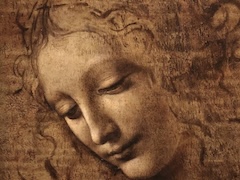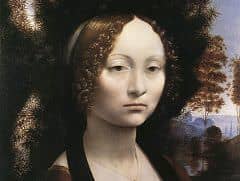Lady with an Ermine by Leonardo da Vinci

Lady with an Ermine is a painting by Leonardo da Vinci, from around 1489-1490. That stunning picture is 40.3 cm wide and 54.8 cm high, oil on walnut board. Unfortunately, the original background has been overlaid probably in the 17th c. The subject of the portrait is identified as Cecilia Gallerani, and was probably painted at a time when she was the mistress of Lodovico Sforza, Duke of Milan and Leonardo was in the service of the Duke.
Lady with an Ermine has been heavily over-painted. The entire background was darkened, her dress below the ermine was retouched and a transparent veil being worn by the woman was repainted to match the colour of her hair. The result of this last retouching has been to give the appearance that her hair reaches down and underneath her chin. Yet another change was the addition of dark shadows between the fingers of her right hand, a close look at the bottom two fingers shows they are quite inferior to the others after an unknown restorer repainted them. An x-ray of this painting revealed the presence of a door in the original background.
Leonardo's Lady with an Ermine is one of the most important works in all of the Western art. Only a handful of authentic panel painting of him survive. Enormously curious, Leonardo often painted with experimental materials or abandoned projects once he had mastered the formal challenge each presented. An object of the greatest rarity, the Lady with an Ermine is a captivating image of exquisite elegance and reveals the artistic genius of Leonardo da Vinci's incomparable creative mind.
Story of This Famous Painting
The Lady With An Ermine' came into Polish hands in 1800, after it was bought by the young Prince Adam Czartoryski (later a hero in the fight for Polish independence) during his tour of Italy. The painting was for his mother, a keen collector and the foundress of the Czartoryski Museum.
Princess Izabela may have been a great patriot but her handling of the Leonardo painting would have given modern art historians a heart attack. 'If it's a dog, it's a very ugly one' she remarked on receiving the portrait from the gallant Prince Adam. Taking a disliking to Leonardo's blue background, the Princess promptly had it painted jet black, and then painted on an erroneous title 'La Belle Ferronniere'' (a portrait that now hangs in the Louvre).
What is perhaps more astounding is the painting's survival. Forced into exile on many occasions, walled up in hidden cellars in country palaces and then stolen by Cracow's wartime Nazi governor, The Lady has not had an easy ride (The Czartoryski's Raphael is still missing to this day, and an empty frame hangs on the wall opposite the Leonardo).
When the Lady With An Ermine was initially retrieved after the Nazi invasion of 1939, an SS soldier's footprint was found on the portrait. It was a fitting metaphor for the attempts that had been made over the centuries to trample Polish cultural institutions, of which the Czartoryski Museum is one of the most radiant.
















